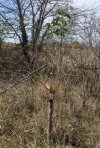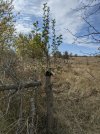Sean98
Buck Fawn
I apologize if this has been asked ad nauseam, but I didn't see anything directly on point in a quick search.
I live in NE Kansas and we're right on the verge of the "escape" of callery pears out of housing subdivisions and into the countryside. There's a few here and there, but not the massive amounts they have south of the Kansas City area. We've been cleaning some pastures up, removing some undesirable trees, and this last weekend I began to wonder if there was a better use for some of this volunteer ornamental pear rootstock? Particularly worth noting given the absolute perfect location of a few of these trees. Well drained slight slope, catching lots of early morning sun in an area that deer really like to travel. It's a good area, but just rocky enough to be a real b***h to try and dig a hole big enough to do a good job planting a new tree.
Internet searches on, "can you graft fruit pears onto callery pear rootstock" seems to make me believe it's possible. But it's more of the, "why not give it a try" than it is YES! or NOOOO!!
So, questions for you folks... Can it be done? And more importantly, SHOULD it be done? I'm sure I'll deal with some vigorous suckering, but if I can take an established root system in an ideal location and jump-start that into a productive fruit tree I'd sure like to give it a try. (at least next year as I hadn't saved any scions this year)
I appreciate any insight/advice/tips/warnings anyone can provide.
I live in NE Kansas and we're right on the verge of the "escape" of callery pears out of housing subdivisions and into the countryside. There's a few here and there, but not the massive amounts they have south of the Kansas City area. We've been cleaning some pastures up, removing some undesirable trees, and this last weekend I began to wonder if there was a better use for some of this volunteer ornamental pear rootstock? Particularly worth noting given the absolute perfect location of a few of these trees. Well drained slight slope, catching lots of early morning sun in an area that deer really like to travel. It's a good area, but just rocky enough to be a real b***h to try and dig a hole big enough to do a good job planting a new tree.
Internet searches on, "can you graft fruit pears onto callery pear rootstock" seems to make me believe it's possible. But it's more of the, "why not give it a try" than it is YES! or NOOOO!!
So, questions for you folks... Can it be done? And more importantly, SHOULD it be done? I'm sure I'll deal with some vigorous suckering, but if I can take an established root system in an ideal location and jump-start that into a productive fruit tree I'd sure like to give it a try. (at least next year as I hadn't saved any scions this year)
I appreciate any insight/advice/tips/warnings anyone can provide.

